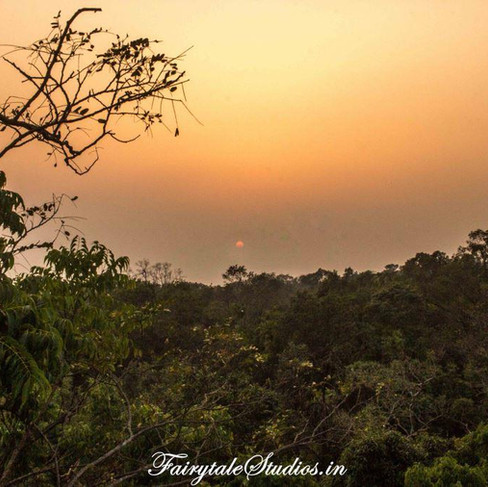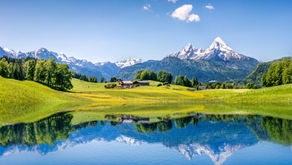Travel Guide to Mawlynnong - The Meghalaya Odyssey
- Fairytale Studios
- Jun 17, 2018
- 10 min read
Updated: Jun 12, 2020
Through misty mountains, clear streams, beautiful waterfalls and picturesque living root bridges, Meghalaya, India offers an ideal getaway for the nature lovers and the romantics. Meghalaya is a doorway to heaven with swirls of clouds passing beneath you amidst the green and vast landscapes. On our trip across Meghalaya, we learnt and discovered various facts about their culture and tradition, one being importance to cleanliness. Most travel enthusiasts would have heard of our next destination as Asia's cleanest village - Mawlynnong. Our love for rural India and a strong desire to see the lives of locals up close made us spend more time at Mawlynnong. And we enjoyed every second of our stay in this beautiful village also nicknamed - 'God's own Garden'.

In this seventh blog of the series – The Meghalaya Odyssey we present a detailed travel guide to Mawlynnong (Pronouned - Maw-leen-ong, Maw rhymes with Law, Leen rhymes with Keen, Ong as in Song), the cleanest village in Asia, along with recommendations around stay and itinerary.
'The Meghalaya Odyssey' is a series of 10 travel blogs and 2 photo blogs. Check out other blogs in the series by clicking on the below mentioned links or photographs:
8. Mawlynnong (Asia's cleanest village) Travel guide - This article
We had read a lot about the cleanest village of Asia located in Khasi hills of Meghalaya and we decided to tick it off our travel plan by including it our itinerary. When Indian government launched the Swacch Bharat Abhiyan (Clean India Mission) in 2014, little did we know that Mawlynnong is already way ahead of the curve. Mawlynnong was adjudged as the ‘Cleanest Village in Asia’ in 2003 by Discover India magazine and later popularized by BBC in 2005. The only reason Mawlynnong received this honour in 2003 and not earlier is because this is when a road was built connecting it to rest of the towns and cities. So this is when media reached Mawlynnong. This claim of such prestigious title stuck with Mawlynnong and today this village has become a source of pride to the country, the state and the villagers.

Mawlynnong is, often, presented as a day-trip to be covered among a bouquet of Meghalaya destinations. However, this scenic village located in the Khasi hills is definitely a place to stay and soak in its essence. We decided spending a night in Mawlynnong and knowing more about the village, the villagers and the culture.
Mawlynnong - The Village:
Situated about 100 kilometers from the capital city of Shillong, the drive to Mawlynnong is picturesque with undulating hills and huge green farms. As we neared the village, we spotted hand-woven, cone shaped baskets used as dustbins placed at specific distance at both the sides of the road. At the entry gate, we were urged to pay a fee of INR 50 for our car to enter the village. We learnt that this money is used for further cleansing the village of the plastic waste and other forms of garbage produced by the visitors.
As we drove inside, towards the village parking lot, we felt as if we had entered some 5 star resort. The road was well constructed with lots of greenery and flowering plants on both sides of the road. The bamboo basket dustbins were seen at every nook and corner of the village. No garbage, no plastic, no other form of waste was visible anywhere throughout.

Our Home stay at Mawlynnong:
A unique feature of Mawlynnong is that there are no hotels or resorts inside the village. The villagers give out a room or two in their house to the tourists as homestays. They take care of all the needs of the tourists and hence earn some money out of it. We had booked one such home stay in Mawlynnong after lot of research and we were going to stay at Ha-La-I-Trep Cottages catered by Mr. Lanphrange. Our homestay cottage was rustic but beautifully made out of bamboo. The room was just sufficient to have a bed and a small table. The bathroom was attached and had a geyser. We were even surprised to see a coffee maker and a heater in the cottage. The verandah in front of the cottage was full of colorful flowering plants and a few chairs to relax and have a good chat. Mr. Lanphrange was extremely hospitable and was patient to answer our curious questions about the village.
Some quick facts about Mawlynnong:
We learnt that the word Mawlynnong means ‘Cavities in a rock’ (caused by rainwater) and we were happy to spot so many Mawlynnongs (rocks with cavities) in Mawlynnong (village). Mawlynnong is a small village with roughly 100 households. A commendable feature of the village is that it maintains a perfect balance between their culture and modernization. The villagers have not sacrificed their tradition to suit the demands of the increased tourism. Agriculture is the main occupation of the villagers and betel nut is their principal crop. The village has one school and it boasts of 100% literacy. Almost everyone was able to speak and understand Hindi and English.
Life in Mawlynnong:
Cleanliness –
The first question that intrigued us was – How did this village become a model of cleanliness and sanitation in the country where waste management has always been a major problem? Mr. Lanphrange proudly answered that the thought likely arose from a cholera outbreak 100’s of years back. Cleanliness was encouraged that time to control the spread of the deadly disease. Early Christian missionaries helped in implementing and encouraging the practice of cleanliness and sanitation. And since then this culture was ingrained in each child when they were young. In other words, it isn’t a habit, it’s an age-old tradition. The children since grade 1 or 2 are expected to keep their surroundings clean.
Since more tourists have been visiting the village, many of whom have a habit of littering, villagers are employed on rotational basis to clean the common areas of the village. They are also held responsible for emptying all the dustbins throughout the village and separating organic waste from other non-biodegradable waste. In the village’s innovative waste management system, the biodegradable waste is buried and later used as manure and the non-biodegradable waste is taken far off from the village and is burnt. Each villager is responsible for the beautification of the village and dedicated village gardeners are responsible for growing and maintaining public plants and flowers that line up the footpaths.
Sanitation –
Mr. Lanphrange explained that around late 1980s, the village headman had decided there should be no open defecation and in couple of years every house in the village had a toilet in it. This is surely a big achievement in pre-liberalization days of Indian economy. The children are also taught basic rules of hygiene and sanitation. As for the individual houses, each homeowner is responsible for cleaning and maintaining his/her house and the surroundings.
Rules regarding cleanliness and sanitation are set at the Village Panchayat and are followed by one and all; where the defaulters are strictly penalized. Another advantage is that the village, being a Khasi land, follows matriarchy (elaborated in introduction to Meghalaya) with women in dominant roles – who play a big part in keeping the home and surrounding neat and tidy and in order. Cleanliness is considered as playing one of major role in living a good life at Mawlynnong.
Smoking and usage of plastics are strictly banned in Mawlynnong. Even the tourists are urged not to throw their plastic bottles in the waste bins and to carry them out of the village themselves. The village head assigns different tasks to each villager on Saturdays like cleaning school, ponds, and so on. These extra tasks are good for the society and the village. Most of the villagers are Christians and on Sundays, everyone takes a holiday, goes to church, relax, chat and enjoy.
Our Experience in Mawlynnong:
Several small lanes are formed from the main parking lot that takes one to the place of residence of the villagers. We explored the entire village by walking in these lanes. An evening and a morning walk for 2-3 hours each should be adequate to cover the entire village. While taking a stroll in the village we found that each and every house has clean and green surroundings. The patios are covered with colorful orchids and bougainvillea with perfectly maintained walkways and gardens. Once cobbled roads are now cemented pathways but most houses still prefer traditional wooden houses built on wooden stilts.

We were surprised to see various flowering plants which we had only seen in school textbooks during childhood. Almost every house has a basin in their front yards for rain water harvesting. Just wandering in the village is incredibly pleasant. A beautiful church, a big football ground and a school adds charm to the beauty of the village. To us, Mawlynnong provides a perfect setting to stimulate the minds of writers and poets. Increasing tourism has helped the villagers in generating revenue by setting up small businesses – like souvenir stalls, home stays, guide services, eateries and restaurants.
But often fame and popularity have downsides too and Mawlynnong is no exception. In peak travel season, Mawlynnong receives up to 300 tourists per day, degrading the simple lifestyles of the villagers and picturesqueness of the village. Increased complaints of noise pollution and air pollution have been received which has urged the village panchayat to construct a new parking lot further away from the village. But the good thing is that the villagers have accepted all these downfalls as part and parcel of their life and strive hard to maintain the title of Cleanest Village of Asia.
Places to Visit in and around Mawlynnong:
1. Nohwet view point, Nohwet
Nohwet viewpoint is a man-made skywalk or an observatory made of bamboo. It is located on the outskirts of Mawlynnong in a village named Nohwet. One can see hills and valleys from here and if you are lucky, fog and clouds can look magical. Nohwet viewpoint also has lovely seating areas made from bamboo. Despite being made of bamboo, the skywalk is extremely sturdy and has lot of strength to easily carry 5-8 people. We also learnt that every monsoon, the skyviews would be damaged and they create new ones once rains recedes. One can spend 15-20 minutes here.
Entrance fee – INR 30 per head
2. Jingmaham Living Root Bridge, Riwai
Similar to, but denser than, the Double Decker root bridge of Nongriat, this Single Decker living root bridge in neighboring village of Riwai is a must visit destination. While the Double Decker living root in Nongriat involves a full day of trekking, Jingmaham living Root Bridge is easy to reach. A small trek of about 150-200 steps takes one to the beautiful creation of nature. This bridge lies between the villages of Nohwet and Riwai. The trek is through lush green surroundings and dense foliage. We learnt that the bridge is 180 years old and is used to cross the Thyllong River (River of Gods) that flows beneath the living root bridge. The bridge is 30 meters long and one is allowed to walk on it to cross to the other side. Standing on the bridge is however prohibited. Visit to the living root bridge might take around 1.5 hours. There are also many small shops lined on the way to the bridge where you can buy gifts, souvenirs and eatables.
Entrance fee – INR 10 per head

3. Balancing Rock in Mawlynnong
This is a unique natural phenomenon where a small stone is balancing a bigger boulder. The structure has remained as such since ages and was worshiped as an ancient shrine by Khasi tribes before the advent of Christianity. It should not take you more than 10 minutes to visit this place.
Entrance fee – INR 10 per head
4. Bangladesh viewpoints in Mawlynnong
Skywalks similar to the one in Nohwet are also constructed in Mawlynnong. They are around 4 storeyed tall and rise above the tall trees to provide an incredible view of Bangladesh plains. It is ideal to watch sunrise or sunset from these skywalks. Note that these too would have entry fees of around Rs.20-30 per head.
Apart from the above mentioned places to visit, there are a few waterfalls and many more living root bridges located inside the nearby forests. Local guides can be hired from the village who could take one deep into the forests to see these beautiful natural wonders. Depending on availability of time, we learnt these expedition deeper into forests can range from 2-5 days.
How to Reach Mawlynnong:
Local shared taxis to Mawlynnong charging INR 250-300 per head run from the capital city of Shillong. You can also hire a private cab from Shillong or Cherrapunjee to reach Mawlynnong.
Duration of Stay in Mawlynnong:
Tourists mostly visit Mawlynnong as a day trip from Shillong or Cherrapunjee. But to soak in the real essence of the village and learn more about its culture, we recommend spending at least one night in the village.

Where to Stay in Mawlynnong:
There are several homestays in Mawlynnong where the villagers welcome guests in their home and make arrangements for their comfortable stay. We certainly recommend staying in Mawlynnong with Mr. Lanphrange in his wonderful quaint cottages named Ha-La-I-Trep cottages. As mentioned above in the blog, we experienced clean rooms, spotless bed and extraordinary hospitality on our stay there.
However, on one of our leisurely walk in the village we noted down the contact of a few of the homestays we came across. Please find the list below. Kindly note that we have not experienced staying with any of them, except Ha-La-I-Trep homestay, and hence cannot comment on the kind of stay they offer.
Ha-La-I- Trep Bamboo Cottages - 9856161773
I Lajong Guest House – 9615043027
One Sister and two Brother’s Homestay – 8575262008
E.B & Sis Homestay – 8014908645
Sah Pyngngad Homestay – 9615724352
Ha-La-Tyngkong Homestay – 9615973768
Where to Eat in Mawlynnong –
Two restaurants located right at the central parking area, serve simple yet delicious meals. We had our dinner – a mouth-watering Veg. Thali at the Dapbiang restaurant (Find the menu below). We savored breakfast of hot momos and Maggie at Naphi Food stall. You can even inquire with your home-stay if they provide any meals. Apart from these, a few tea stalls are scattered here and there in the village and may also serve some light snack.

What to Expect in Mawlynnong:
There isn’t any luxury hotel or restaurant or ATM or petrol pump in the village
Mobile phones may not catch any network and there is no Wi-Fi
The hospitality of the villagers will touch your heart and their kindness will touch your soul
Try to learn their outlook of life and appreciate the innocence in their language
You will learn that lifestyle and state of mind is a choice and has little to do with money
You will learn that less is more
You will be stared upon if you throw any rubbish on the roads or lanes
PIN THESE IMAGES



Hope this in depth guide to Mawlynnong would help you chart a detailed itinerary and make your bookings for stay. View more photographs of the cleanest village of Asia, Mawlynnong, in our photo blog here. Would you like to visit this beautiful village? Would you like us to add any other detail? Do let us know your thoughts in comment section below.























































































































Comentários